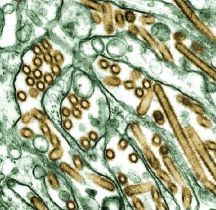FAO: Eliminating H5N1 will take more than 10 years

Because of deep-rooted barriers, there is little chance that H5N1 avian influenza can be expelled within the next 10 years from the six countries where it remains entrenched, the United Nations Food and Agriculture Organization (FAO) says in a new report.
Most of the 60-plus countries that reported H5N1 in 2006 have eliminated it since then, but it remains endemic in China, Vietnam, Indonesia, Bangladesh, India, and Egypt, notes the report, titled “Approaches to Controlling, Preventing and Eliminating H5N1 Highly Pathogenic Avian Influenza in Endemic Countries.”
Three major obstacles
The FAO says the elimination effort faces three major obstacles in these countries: the structure of the poultry industry, the quality of veterinary and animal production services, and the level of commitment by all sectors.
“Although measures have been introduced in all endemically infected countries to address these three factors, all require further long-term commitments and investment if the virus is to be eliminated,” the report states. “It is now generally accepted that the H5N1 HPAI [highly pathogenic avian influenza] virus is unlikely to be eliminated from poultry in these countries and regions for the next ten years at least.”
Poultry vaccines
Further, the report says “there is no guarantee that the current incremental approach will eliminate H5N1 HPAI.” The goal may require innovative measures such as new, easily deliverable poultry vaccines and genetic manipulation of poultry to make them resistant to the virus.
As long as H5N1 outbreaks continue, so will the risk of the virus evolving into a human pandemic strain, the report notes. Several of the H5N1-endemic countries have had human H5N1 cases this year, with Egypt leading the list with 22 confirmed cases so far.
Nature of poultry business
The nature of the poultry business in the countries still plagued by H5N1 makes elimination difficult, the FAO report says. Production and market chains are “complex and poorly integrated,” a large share of poultry are reared and sold in conditions that offer little protection against avian flu, many poultry (such as domestic ducks) don’t show signs of the disease when infected, and supporting entities such as producer associations are weak.
Changes are being made in the poultry sector, but they won’t eliminate all high-risk practices, such as free-grazing ducks, the report adds.
Source: CIDRAP













